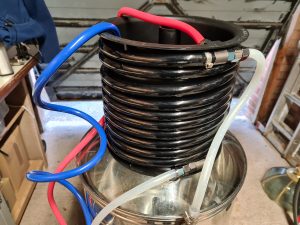Cooling
 The ‘crud’ that is generated during the boil will sink to the bottom of the boiler. This crud consists of proteins, carbohydrates and oils, which stick together. If this crud is allowed to remain in the wort that is transferred to the fermenting vessel (which is referred to as the ‘cold break’ when it is cooled), it can cause a ‘chill haze’ when the finished beer is ultimately chilled. Although this is a purely cosmetic problem and will not affect the taste, it’s best avoided.
The ‘crud’ that is generated during the boil will sink to the bottom of the boiler. This crud consists of proteins, carbohydrates and oils, which stick together. If this crud is allowed to remain in the wort that is transferred to the fermenting vessel (which is referred to as the ‘cold break’ when it is cooled), it can cause a ‘chill haze’ when the finished beer is ultimately chilled. Although this is a purely cosmetic problem and will not affect the taste, it’s best avoided.
Another method of cooling the hot wort is to use an immersion cooler. This is a coil of copper tubing, which is immersed into the hot wort after boiling, and through which cold tap water is fed. This takes longer to cool the wort than using a counter-flow cooler, but allows the cold break material to settle at the bottom of the boiler. Once the cooled wort is siphoned into the fermenting vessel, the cold break is left behind in the boiler.
After the cooled wort has been transferred into the fermenting vessel, it’s important to re-oxygenate the liquid (boiling removes oxygen). Oxygen content is important for the yeast action. Try to splash the liquid as it’s transferred into the fermenting vessel . The splashing action will introduce oxygen to the wort enabling a healthy start to fermentation. It’s also a good idea to then oxygenate the wort further by vigorous stirring for 10 minutes. This gives the yeast cells plenty of oxygen, enabling them to multiply, resulting in a healthy fermentation.
